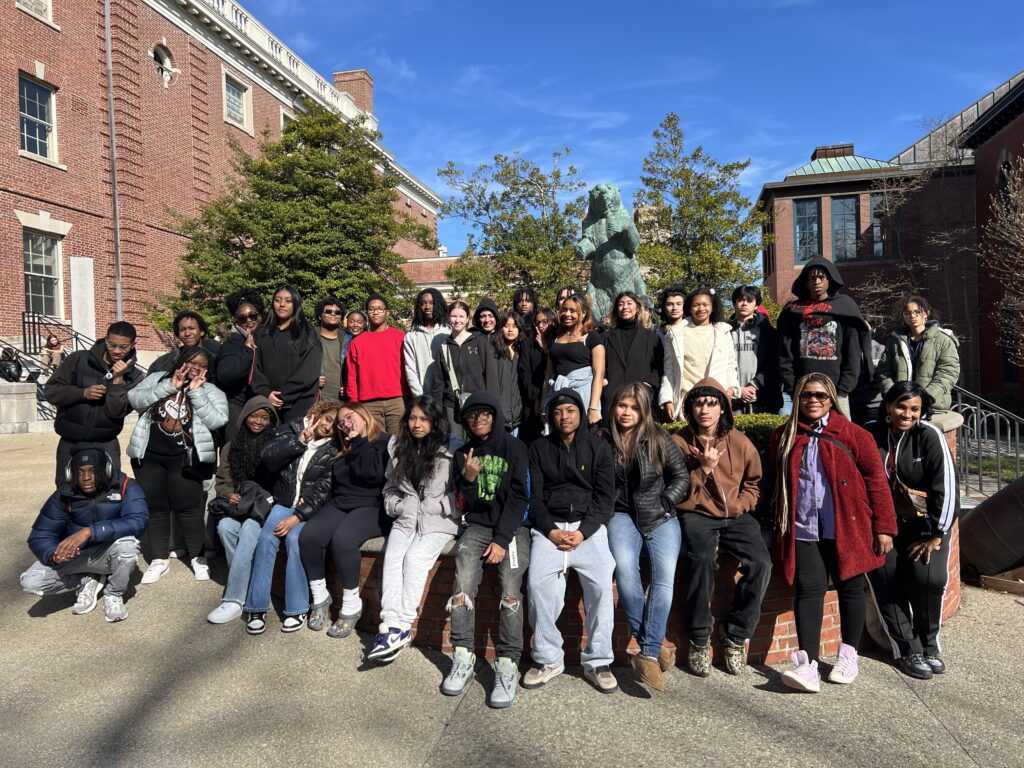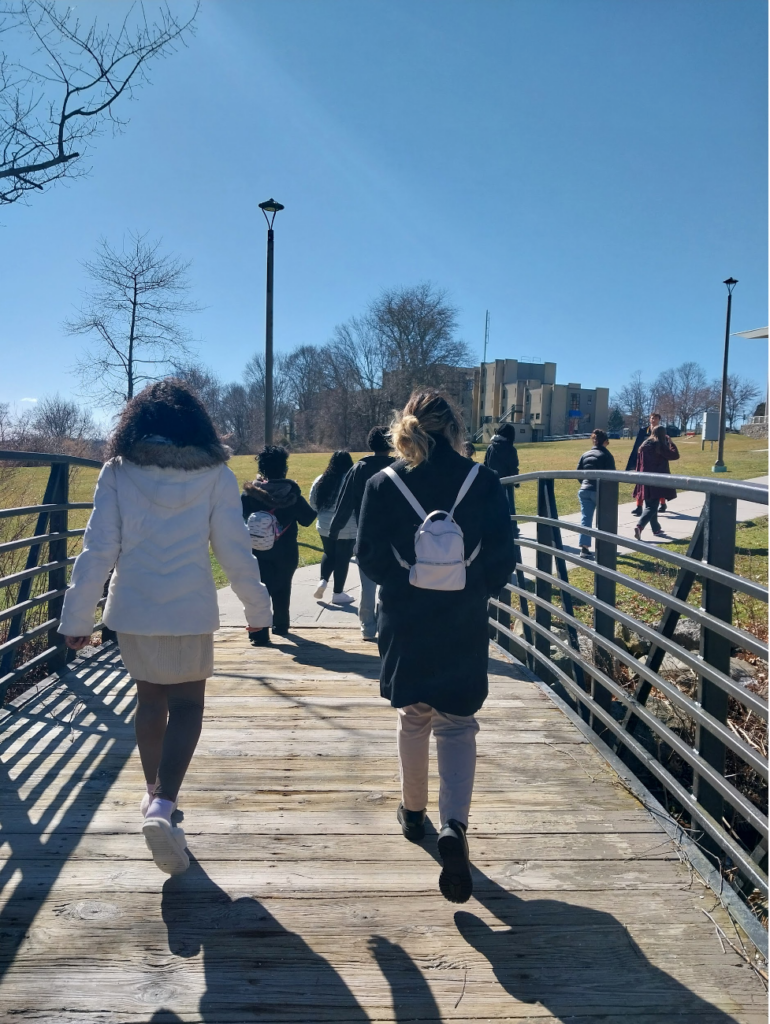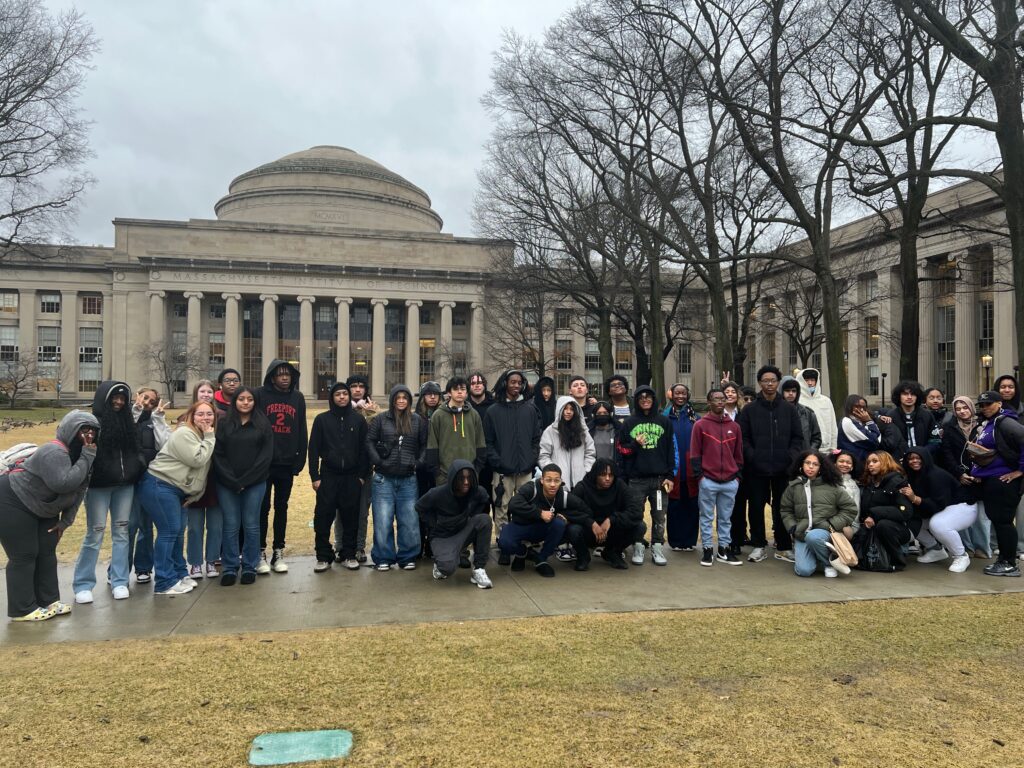In early March, some WHSAD Juniors had the opportunity to further their knowledge of college environments and standards through an overnight trip into New England, starting in Boston, hitting Boston Architectural College and MIT, then heading down through Rhode Island for Roger Williams and Brown. All of these schools were uniquely different in the programs offered, campus, and student life. With such a diverse selection, students had the opportunity to learn more about the kind of school they hope to go to, small or big, urban or suburban, relaxed or intense. Additionally, it helped inspire students to work for the future they desire.

After a lengthy bus ride and a pitstop for lunch, the group arrived at Boston Architectural College. It’s a very small school, being only two buildings total. It is located in a beautiful area, right in central Boston. When the school was first founded, it functioned as a night school, so students could work during the day while they finished their degrees, and the school still follows a similar model of education today. Most of the classes are in the afternoon or night, and most of the students are employed with help from the school. This way, they graduate with both a diploma and work experience, meaning they won’t have to wait to become a licensed architect. Within the school they have studio space for everything you could need: independent projects, collaborative spaces, computer labs, and machinery. Additionally, BAC supplies its students with materials for their projects.
Just across the river in Cambridge is MIT, or Massachusetts Institute of Technology. Being one of the most prestigious schools for math and science in the world, they are equipped with desirable and advanced technology, famous pieces of architecture, and some of the most intelligent minds in the world. The school is famous for its research resources, including large lab buildings for all areas of science. They have a confusing and admirable mix of historic and funky-modern buildings around their medium sized campus. In addition to their prestige and scholarly student body, MIT has managed to build a tight knit community. Students are known to pull large scale pranks, including putting a university police car on the room and hooking up screens to the windows of a large building to play Tetris.
After a long day of college touring the group stopped by Dave and Busters for dinner and games. It was a nice way to wrap up day one, blowing off some steam bottled up from the hours on the road. Afterwards, we headed to the hotel and prepared for another day of adventure.
The next morning, after a hotel breakfast and slow wake up, we headed south to Rhode Island. Arriving at Roger Williams University, you can immediately feel a change from the more urban vibe of the Boston colleges. Located on a peninsula in a coastal town, the school has advantageous opportunities for marine exploration. In fact they are a D1 sailing school, second only to Yale in the United States. Additionally, they have a wonderful Marine Biology program, as well as Architecture. In the marine lab, students have the opportunity to grow shellfish to repopulate the overfished community in the bay next door. Another medium sized school with a beautiful campus, many of the student dorms face the water. In their architecture building you’ll find hundreds of designs on display, and personal studio spaces for each student, starting freshman year. Most schools won’t give you a personal studio space until senior year, so this is a privilege.
Last but not least, the students headed over to Providence to see the Ivy League school Brown University, with a small, but historical and beautiful campus. Getting off the bus the first thing students noticed was the group of students protesting just outside. This is just one display of the vocal and active community at the school. Their unique approach to learning allowed for lots of exploration before deciding a major. Even after, the school partners with a nearby liberal arts school to allow their students to design their own career. For example, a past student took astrophysics and fashion design, and they now work designing suits for astronauts. The school also has a “pay what you can” policy, meaning once you are accepted they will evaluate how much money you make, and translate it into tuition. They do not give out loans or merit based scholarships, meaning they give you as much money as you need based only on your financial situation, and you are not required to pay them back and your ability to pay will not affect your acceptance to the school. Brown is another research school, so students have options to get paid helping professors during the school year or over the summer with research projects and internships.
WHSAD Junior, Amina Clyde wrote the following reflection.
Often in a student’s junior year, it is common for them to participate in college trips to prepare them for senior year and picking colleges in the very near future. However in WHSAD, students participate in overnight college trips to see multiple colleges in one go to broaden their options. The first overnight college trip, post Covid, occurred this year and covered a total of four colleges.
For the first day, we took a long drive to Boston to see the first college, Boston Architectural College. Prior to the school’s visit, students went to Faneuil Hall and had time to buy food items using a new system of a twenty dollar card given to each student. At the end of the market trip, students return the card regardless of whether they spent all the money or not. Once students and chaperones ate, the bus took a short drive to the college where students were given a brief presentation on the college to know what to expect/how to get into the school.
After that, the students were split into two groups, and a BAC student gave a tour of the campus. Boston Architectural College focuses on architecture and isn’t the college to go to if you are looking for sports or anything aside from architecture. However, we were advised by our tour guide to continue to do an architecture degree, even if you did not want to be an architect, because that degree could get you much further in that industry. Towards the end of the tour, we visited the library and got a visit to the older part of the library that was there since the college opened and had books dating back decades.
After that, students got back on the bus to go to MIT, our second college of the day. The tour mimicked the first, with the exception that there was no presentation before it and we were mainly led by a student from the school. Our tour guide gave us the inside scoop as to all the pranks that go on at MIT, specifically at one of the buildings there. Along with that story, students also got to see some rogue geese that also occupy the campus.
Bringing an end to such a long day, students get back on the bus once more to drive to David Busters, where we ate dinner and relaxed before going to a hotel. Once the dinner was over, we got back on the bus for the last time in the day to drive the short distance to the hotel where we stayed for the night.
The hotel rooms are determined way in advance before students even finalize handing in all their permission slips. This is for a smooth time at the hotel to make sure not only that students all get a room they are comfortable in, but that such a large group is not an inconvenience to the hotel. Most students in the room each get a room key to go in and out of the room, but there is a curfew that requires us to be in the room by 10:30.
In the morning, students ate breakfast at the hotel before packing up to go to the next set of schools: Roger Williams University and Brown University. Similar to Boston Architectural College, Roger Williams provided a presentation of what to expect at the school before we were given a tour by one of the students there.
In my personal opinion, Roger Williams had the most intricate programs and clubs compared to the ones I had seen in other colleges. They have sailing clubs and work with sea creatures that live in the water by the school. The way that they work their major systems is unique to their school and the history behind the statue that lives there is quite comical. Many assume the statue on campus is of Roger Williams, however, it is not. It is of a different man because Roger Williams did not believe in self portraits as he thought they were vain. The face of the statute was loaned to the school and has been there ever since.
The next and last trip on the list was Brown University. Our entrance was quite odd compared to the other three colleges because we were approached by protesters when we arrived. Students protested the firing of a recent tour guide who was removed for his activist perspectives. It put an awkward start to the end of our trip.
We pressed on to eat at the cafeteria quickly before we were taken for a presentation. After that, we were led around for a brief tour of the campus. I will admit out of all four colleges, I didn’t really like the tour because we only had one tour guide and it was the full group making it very hard to hear outside and with people talking next to me, even if it was just whispers. On top of that, it was the shortest campus tour, and we didn’t really get to see interiors of the university, mainly the outside parts, which mostly looked the same.
Aside from the trip itself, college trips are important to give the opportunity to see schools out of state or out of New York for free. For me, it opens my perspective and thoughts on whether I want to stay in the city for college.

Student Perspectives:
I asked students who went on the trip two questions:
- What did you gain from the trip?
- Why are college trips beneficial for juniors?
Salsabil
- “Hmmm, I gained a lot of knowledge about different colleges that we visited like the specific things the colleges are interested in and what they focus on the most. College tours are beneficial for juniors because it gives us an idea of the colleges that we might want to go to in the future. The college tours can really bring us out there.”
Amari
- “The overnight trip did two very important things for me. First, the trip allowed me to become closer with my classmates. This trip allowed me to go outside my comfort zone and socialize with people who I’ve never spoken to. Second, this trip gave me more insight on campus life and how communities are formed within a college. I’ve gained a new perspective on college and a new excitement for it. This trip is beneficial for juniors because it allows for students to learn about colleges for free. Many people apply to schools like MIT or Brown University. But they never get the chance to experience college or even see it at all. This trip also allows juniors to expand their options for colleges. I myself had a very small list of potential colleges before going on this trip, and I’m sure many other juniors can say the same.”
Felisha
- “This trip was definitely a euphoric experience for me. Getting to explore a variety of colleges, expanding my knowledge of what it is like to be on campus, and achieving goals and aspirations. These schools gave me an insight into what it is like to be a college student and preparation for the future ahead. As for us juniors, I find these trips to be beneficial, in which even if we are still unsure about what we want to do in life, or if we know what career we want to succeed in. We always will have the support of others, especially when choosing the college we want to go to.”
Chelsea
- “I felt inspiration that you can’t find anywhere else. I saw future artists, poets, engineers- I saw the future of humanity on that campus. Being around such intelligent and inspired individuals made me feel as though there really are beautiful opportunities for everybody regardless of where they come from. It’s beneficial to juniors because it opens our minds. Being told anything is possible is one thing but seeing someone major in psychology and dance? That gives a person hope.”



